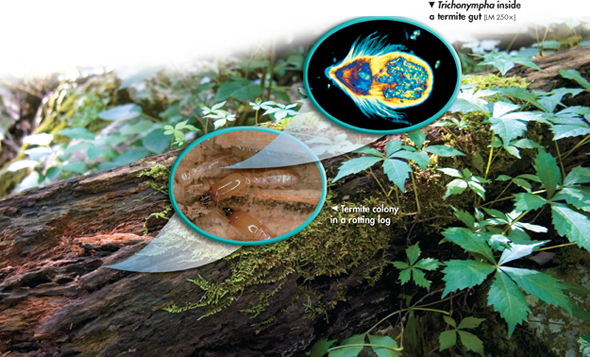Symbiotic Protists—Mutualists and Parasites
 What types of symbiotic relationships involve protists?
What types of symbiotic relationships involve protists?
Given the great diversity of protists, it should come as no surprise that many of them are involved in symbiotic relationships with other organisms. As you know, symbiosis is a relationship in which two species live closely together. Many of these relationships are mutualistic: Both organisms benefit. However, some are parasitic relationships, in which the protist benefits at the expense of its host.
Mutualists Earlier you learned that photosynthetic protists called zooxanthellae are essential to the health of coral reefs. These protists maintain a mutualistic relationship with the animals of the reef, which could not survive without their help.  Many protists are involved in mutualistic symbioses, in which they and their hosts both benefit.
Many protists are involved in mutualistic symbioses, in which they and their hosts both benefit.
Another striking example of a mutualistic protist is Trichonympha, shown in Figure 21–12. Trichonympha is a flagellated protist that lives within the digestive system of various species of termites and makes it possible for the insects to digest wood. Termites themselves do not have enzymes to break down the cellulose in wood. How, then, does a termite digest cellulose? In a sense, it doesn't. Trichonympha does.
Trichonympha and other organisms in the termite's gut manufacture an enzyme called cellulase that breaks the chemical bonds in cellulose, making it possible for termites to digest wood. With the help of their protist partners, then, termites can munch away, digesting all the wood they can eat.
ZOOMING IN
A PROTIST MUTUALIST

FIGURE 21–12 Trichonympha is a wood-digesting protist that lives in the digestive system of termites. Digestive enzymes produced by the protist break down the particles of wood, which you can see inside the protist's body. Predict What would happen to a termite if its Trichonympha colony died?
Table of Contents
- Formulas and Equations
- Applying Formulas and Equations
- Mean, Median, and Mode
- Estimation
- Using Measurements in Calculations
- Effects of Measurement Errors
- Accuracy
- Precision
- Comparing Accuracy and Precision
- Significant Figures
- Calculating With Significant Figures
- Scientific Notation
- Calculating With Scientific Notation
- Dimensional Analysis
- Applying Dimensional Analysis




